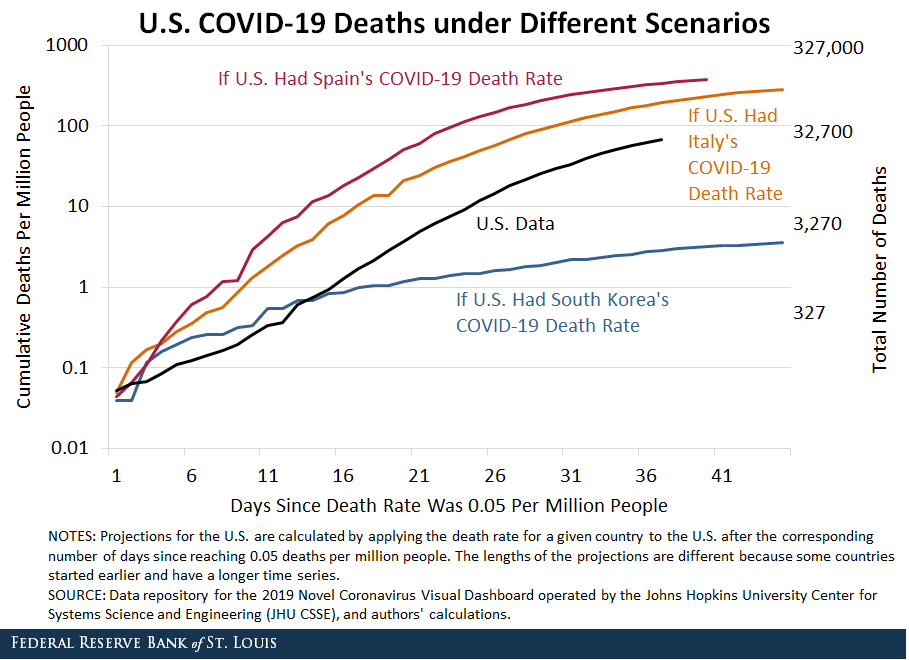Is the U.S. Looking Like Italy? Projections on COVID-19 Death Rates
We pose a counterfactual question in this blog post: What if the COVID-19 death rates in the U.S. followed the pattern in countries such as Italy, South Korea or Spain?
We used the actual number of COVID-19 deaths in other countries to calculate projections for the U.S. (For daily updates on the projections, visit the St. Louis Fed’s Research webpage: Daily Data and Projections on COVID-19 Death Rates.)
For example, consider the following calculation involving Italy: Starting with a threshold death rate (say, 0.05 deaths per million people in the population), we know what the death rate in Italy was each day after that threshold was reached. We then applied the Italian death rate to the U.S. after the corresponding number of days since the U.S. reached the same threshold for its population.As of March 21, the U.S. had 327 deaths related to COVID-19. The U.S. population is 327 million, so its death rate on that day was 1 per 1 million people. The population of Italy is 60 million. As of March 2, Italy had 60 deaths related to COVID-19, so its death rate on that day was 1 per 1 million people. This is illustrated in the figure below.

The right axis gives the total number of deaths, the left axis gives the death rates per 1 million people in the population, and the x-axis tracks the number of days since the death rate for each country was 0.05 per 1 million people.
The U.S. had 16 deaths by March 7—a death rate of 0.05 per 1 million people. It took 28 days for South Korea to go from a death rate of 0.05 per million people to a rate of 2 per 1 million people. If the U.S. had followed South Korea's pattern of death rates, U.S. deaths would have reached a rate of 2 per 1 million people on April 4. In reality, it reached that death rate on March 24, or 17 days later. The U.S. and South Korean paths have been diverging for several weeks now.
Is the U.S. path beginning to look more like the Italian path?
- Italy took three days to go from a death rate of nearly 10 per 1 million people to a rate of 20 per 1 million people, while the U.S. took four days.
- Italy took nine days to go from a death rate of nearly 10 per 1 million people to a rate of 50 per 1 million people. The U.S. took 10 days.
Furthermore, Italy’s path is showing signs of tapering off: The daily deaths in Italy have plateaued for about two weeks around 12 deaths per 1 million people, while U.S. deaths have continued to increase. The figure below illustrates the ratio of daily deaths per 1 million people in the U.S. to the corresponding number in Italy; the ratio is a “smoothed” line that best fits the data.

On day 10—that is, 10 days after reaching the threshold death rate of 0.05 per 1 million people—the daily death rate in the U.S. was less than 20% of the rate in Italy. On day 35, it was more than 40%.
While the U.S. exceeded Italy in the total number of deaths as of April 11, the number of daily deaths adjusted for population is less in the U.S. than in Italy. However, the general trend over the last four weeks suggests that the U.S. seems to be on its way to catching up with Italy on that metric.
Notes and References
1 As of March 21, the U.S. had 327 deaths related to COVID-19. The U.S. population is 327 million, so its death rate on that day was 1 per 1 million people. The population of Italy is 60 million. As of March 2, Italy had 60 deaths related to COVID-19, so its death rate on that day was 1 per 1 million people.
Additional Resources
- On the Economy: COVID-19: Projected Deaths in the U.S.
Citation
B. Ravikumar and Guillaume Vandenbroucke, ldquoIs the U.S. Looking Like Italy? Projections on COVID-19 Death Rates,rdquo St. Louis Fed On the Economy, April 13, 2020.
This blog offers commentary, analysis and data from our economists and experts. Views expressed are not necessarily those of the St. Louis Fed or Federal Reserve System.
Email Us
All other blog-related questions



